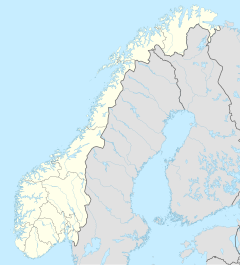Dovrefjell-Sunndalsfjella National Park
| Dovrefjell-Sunndalsfjella National Park | ||
|---|---|---|
| View of the Snøhetta from Rondeslottet | ||
|
|
||
| Location: | Møre og Romsdal , Innlandet , Trøndelag , Norway | |
| Next city: | Trondheim | |
| Surface: | 1,693 km² | |
| Founding: | 01/19/2002 | |
The Norwegian Dovrefjell-Sunndalsfjella National Park was established on June 1, 2002. It replaced Dovrefjell National Park , which was established in 1974. The national park is 1,693 square kilometers. It is located in the Fylken Innlandet , Møre og Romsdal and Trøndelag and is divided by the E 6 into a larger western and a smaller eastern part. The National Park Center with an exhibition and a small botanical garden is located in Kongsvoll on the E 6.
Overview
The main attraction of the national park are the musk ox , which were introduced from Greenland 70 years ago and roam freely within the park. A guided musk ox tour is offered in Kongsvoll (for a fee). The best chances of spotting musk oxen are in Stroplsjødalen and Kaldvelldalen.
The most popular hiking destination in the western part of the park is Snøhetta ( 2286 moh. ), The highest peak in the area. At his feet is the self-service DNT Hut Reinheim (keys available in Kongsvoll). It takes two to three days, and mountain equipment and experience are recommended.
On the northern edge, just outside the national park border, there is an impressive waterfall ( Lage ) on road 70 between Oppdal and Sunndalsøra , over which three rivers pour into Åmotan from a height of 156 m.
A herd of fjord horses live in the eastern part of the park from mid-June to mid-August. The best access is from the E 6 via the RV 29 to Dalen and on to Bekkelegret, the (state) horse station.
To the south of the park is the Fokstumyra nature reserve, which is primarily used for bird protection. Access is strictly regulated during the breeding season from late April to early July. The Dovrefjell-Sunndalsfjella National Park is one of the most important breeding grounds for the double snipe . Around 400 breeding pairs of this IUCN classified species breed there .
… Reindeer in Dovrefjell-Sunndalsfjella
The Pilgrimsleden with the Snøhetta in the background
Dovrefjell with Snøhetta
See also
supporting documents
Web links
- Official website of the Directorate for Naturforvaltning
- Info from the tourist office
- Dovrefjellrådet
Single receipts
- ↑ Archive link ( Memento of the original from January 1, 2013 in the Internet Archive ) Info: The archive link was inserted automatically and has not yet been checked. Please check the original and archive link according to the instructions and then remove this notice.
- ↑ Archive link ( Memento of the original from March 6, 2016 in the Internet Archive ) Info: The archive link was inserted automatically and has not yet been checked. Please check the original and archive link according to the instructions and then remove this notice.
- ↑ Simon Delany, Derek Scott, Tim Dodman, David Stroud (Eds.): An Atlas of Wader Populations in Africa and Western Eurasia. Wetlands International , Wageningen 2009, ISBN 978-90-5882-047-1 , p. 276







